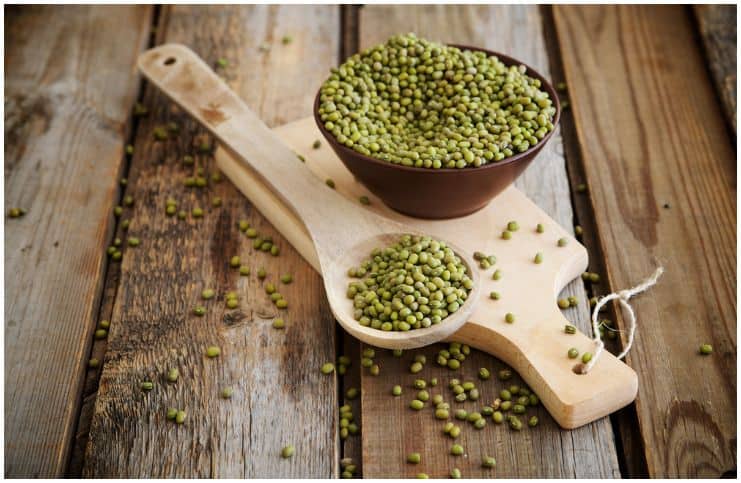Mung Beans Sprouts – Side Effects, Nutrition Facts, Health Benefits:
In China, mung beans (Vigna radiata) are a very popular food, particularly in the summer months. They are cultivated in India, China, and Southeast Asia.
India is the largest producer, with more than 50 percent of world production, but consumes almost its entire production.
A very famous ancient Chinese pharmacologist and doctor, Li Shi Zhen (1518-1593), stated in his book Ben Cao Gang Mu (also known as Compendium of Materia Medica) that “mung beans are highly recommended not only as a rich source of nutrients but also as a medicine.”
How To Cook These Beans
These beans can be served as green pods, forage, dried seeds, vegetables, or seeds for food preparation.
Mung bean sprouts can be stir-fried alone as a vegetable or paired with other vegetables such as ginger, scallion, green pepper, or carrots. Basically, they can be added to virtually any savory recipe.
When cooked, the beans are a hearty comfort food that can be served as a stew, soup, main dish, or dessert.
Nutrition Facts
They are an excellent source of vitamins, such as – vitamin A, B vitamins (thiamin, niacin, riboflavin, folate, vitamin B6, pantothenic acid), vitamin C, vitamin E, vitamin K, minerals – potassium, magnesium, calcium, iron, phosphorous, copper, zinc, and manganese.
Are These Beans Gluten-Free?
Yes.
Substitute
Lentils are an excellent substitute for these beans.
Health Benefits of Mung Beans
Prevents Heart Disease
A 2011 study published in the Journal of Human and Experimental Toxicology found that these beans are highly effective at inhibiting LDL cholesterol oxidation.
They have the capacity to regulate LDL levels because their antioxidants act as potent free-radical scavengers, lowering inflammation and reversing the damage done to blood vessels.
Anti-cancer effects
These beans contain the flavonoids isovitexin and vitexin, which have high free radical scavenging functions. They help lower oxidative stress, the cancer-causative factor.
Furthermore, according to a 2012 study reported in the journal BMC Complementary and Alternative Medicine, the beans suppress the growth of human liver and highly aggressive cervical cancer lines through multiple mechanisms, inducing anti-cancer cytokines, including cytotoxicity, halting the cancer cell cycle, and triggering programmed cell death.
Protein
Vigna radiata has considerable amounts of protein content, approximately 3.16 g of protein per cup.
Getting your protein from plant-based foods means that you’re more likely to have a lower intake of unhealthy saturated fat and dietary (LDL) cholesterol.
Weight loss
Satiety notably increases after consuming these amazing beans. Hence, regularly eating the beans can help with reducing caloric intake and boosting weight loss.
Purification
The tannins, proteins, and flavonoids in the beans are also considered effective for binding to and clearing heavy metals (mercury, cadmium, and lead) and pesticides from the body.
Boosts Immunity
The phytonutrients present in Vigna radiata have potent anti-microbial and anti-inflammatory properties that help in fighting infections and viruses. In addition, it balances the bacteria in the digestive system, helps absorb nutrients, and increases immunity.
A Rich Source of Dietary Fiber
A serving of beans contains 1.9 grams of fiber or 8% of your daily value based on a 2,000-calorie diet. Dietary fiber is probably best known for its ability to prevent or relieve constipation. This is important since 11,500 individuals die annually from diseases related to constipation.
More importantly, a high-fiber diet may lower your risk of developing hemorrhoids. Also, due to the fact that some fiber is fermented in the colon, scientists are looking at how this may play a role in preventing diseases of the colon.
Antidiabetic Effects
Type 2 Diabetes Mellitus affects millions of people every single day. Type 2 diabetes most often develops in people over age 45.
The beans have a low glycemic index of 25, making them an excellent choice for diabetics.
The latest research concluded that reducing fats in your diet (especially from animal sources and vegetable oil) may also help reduce your risks and chances of developing type 2 diabetes and manage diabetes once you have it, even complete healing.
Vitamin C
A 1-cup serving of these bean sprouts contains 23% of your daily value of vitamin C. Vitamin C is used by your body for wound healing and maintaining the health of your teeth and bones and plays an essential role in helping your body absorb iron.
Moreover, vitamin C helps preserve vascular integrity and is proving beneficial in combating other risk factors for cardiovascular disease and endothelial dysfunction.
Pregnancy & Breastfeeding
These beans can be consumed by pregnant or nursing women.
Precautions and Side Effects of Mung Beans
Avoid eating these beans if you have diarrhea or if you frequently experience cold symptoms such as cold feet and hands.
How To Sprout These Beans
- Add 3 cups water, filling the jar three-quarters full, cover with a sprouting screen. Soak the beans at least 8 hours.
- Drain and rinse the beans thoroughly.
- Repeat rinsing and draining 3 times a day until sprout tails appear. Taste sprouts every day. Discontinue rinsing when sprouts have reached the desired length.
- Drain for a few hours before cooking.
Studies reveal that the germination or sprouting of the beans helps to improve their medicinal and nutritional properties. Also, sprouting activates a live, power-packed food with vitamins, enzymes, and minerals.
Additionally, those familiar with sprouting already know that eating sprouted foods is the way to go in order to ensure the natural and fresh nutrition that processed foods lack.
READ THIS NEXT:
Lupini Beans – Nutrition Facts, Health Benefits, Side Effects
Carom Seeds Side Effects & Health Benefits
References http://bmccomplementalternmed.biomedcentral.com/articles/ http://ccj.springeropen.com/articles/10.1186/1752-153X-8-4 https://www.ncbi.nlm.nih.gov/pubmed/18767859 http://www.pulsecanada.com/uploads/


